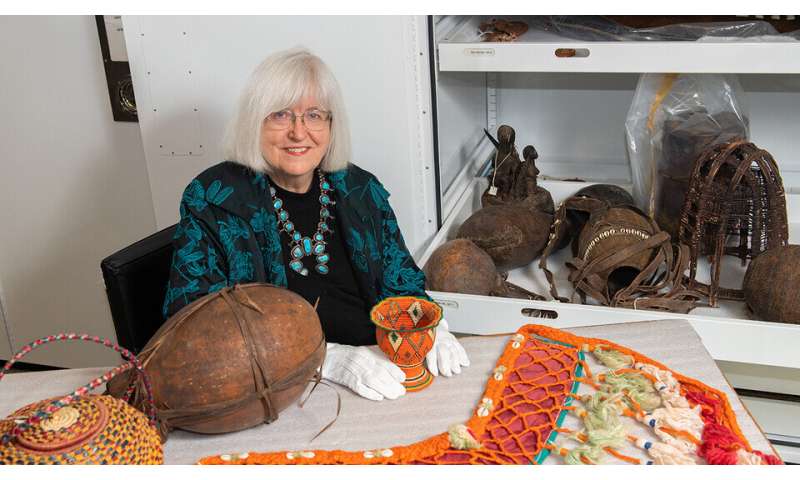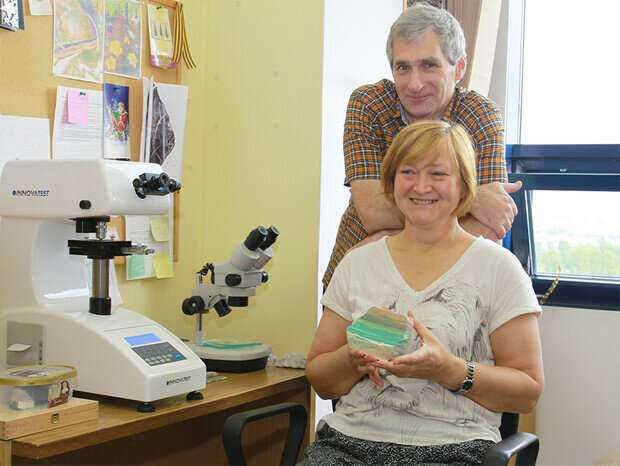#New mineral, ‘priscillagrewite,’ named in honor of renowned Nebraska geologist
“#New mineral, ‘priscillagrewite,’ named in honor of renowned Nebraska geologist”

The greatest Christmas present Priscilla Grew received last year was an email.
Priscilla and husband Ed were vacationing in Hawaii, escaping the respective winter climes of Nebraska and Maine, when it arrived in late December.
It came from another married couple, Irina Galuskina and Evgeny Galuskin, whom Priscilla and Ed first met in 2010 at a meeting in Budapest. And it contained a surprise: “We found a new garnet and would like to name it ‘prisgrewite.’ We hope that Priscilla will agree!”
“I was just totally thrilled and overwhelmed,” said Grew, professor emeritus of Earth and atmospheric sciences and director emeritus of the University of Nebraska State Museum. “There are only about 5,600 (known) minerals, and only about a hundred are named for women.”
Though the Galuskins call her by the Russian nickname “Pris,” the International Mineralogical Association preferred her full name for the recently announced mineral: priscillagrewite-(Y). The mineral is a member of the so-called garnet supergroup, making it the equivalent of a semi-distant relative to more conventional garnet species. What sets it apart from all but one of its garnet brethren—it contains the element yttrium—is also what puts the “Y” in its name.
The Galuskins have honored Grew with their discovery partly as a tribute to one of her own, which she notched in 1966 while conducting doctoral research at the University of California, Berkeley. Alone in a lab at around 2 in the morning, Grew was analyzing a California garnet with a then-state-of-the-art instrument known as an electron microprobe, which fires a beam of electrons at a sample and records the resulting X-rays to identify the elements in it.
“This little picture, like a Polaroid, came out,” Grew said of the black-and-white output. “And there was this geometric pattern of light and dark zones.”

That angular pattern resembled the concentric rings of a tree trunk, she said, with the light zones representing higher levels of the element manganese. The phenomenon, what geologists call oscillatory zoning, indicated that the amount of nearby manganese had oscillated—high, then low, then high again, and so on—as the garnet had grown and crystallized over time.
Grew realized she was the first to observe those manganese zones in a garnet. Then and there, in the middle of the night and Berkeley’s empty Earth sciences building, she celebrated.
“I actually went out in the hall, and I ran up and down the hall, sort of skipping, shouting, ‘Yay!’ It’s the only time in my life that I’ve had a real first-ever-seen-by-human moment.”
It was a major geological achievement in a career that would come to be defined by them. But even before that moment, Grew’s colleagues at Berkeley had taken to calling her the “garnet lady.” Grew said the title has since passed to Galuskina, who, with the co-discovery of priscillagrewite-(Y), has now unearthed and named eight approved garnet species.
The Galuskins named two other minerals, edgrewite and hydroxyledgrewite, for Priscilla’s husband in 2011. Ed “lucked out,” Priscilla said, because the former mineral was already named by the time the researchers discovered the latter, whose similarity in atomic structure and composition ensured it would receive the same root name.
“Since he already had the one, they didn’t have a choice,” she joked. “People are kind of jealous, because you’re only supposed to get one mineral name per person.”
Official samples of Ed’s minerals reside at the Fersman Mineralogical Museum of the Russian Academy of Sciences in Moscow, where a specimen of priscillagrewite-(Y) will soon join them.
if you want to watch Movies or Tv Shows go to Dizi.BuradaBiliyorum.Com for forums sites go to Forum.BuradaBiliyorum.Com
If you want to read more Like this articles, you can visit our Science category.

